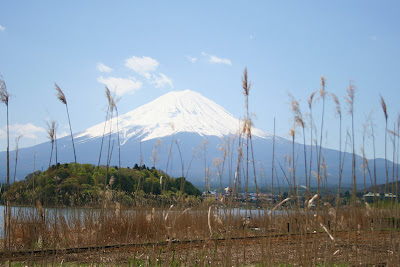 After our great Hakone transportation adventure, Jaime and Brian had to get back to work on Friday, but Davin and I stayed in Gotemba, with plans to visit the Fuji 5 Lakes, a chain of small lakes dotting the north side of Mt. Fuji. We parted ways on the train at sunset, half back to Shizuoka, half off to the Gotemba Kogen Brewery (My glass looks bigger, but his was bottomless).
After our great Hakone transportation adventure, Jaime and Brian had to get back to work on Friday, but Davin and I stayed in Gotemba, with plans to visit the Fuji 5 Lakes, a chain of small lakes dotting the north side of Mt. Fuji. We parted ways on the train at sunset, half back to Shizuoka, half off to the Gotemba Kogen Brewery (My glass looks bigger, but his was bottomless). Kawaguchi-ko looked inviting the next morning, but boating would have to wait. After Indian food, our afternoon was spent spelunking two of the area's many lava tubes formed from volcanic eruptions.
Kawaguchi-ko looked inviting the next morning, but boating would have to wait. After Indian food, our afternoon was spent spelunking two of the area's many lava tubes formed from volcanic eruptions.
 Some great info on what to expect from our cave experience:
Some great info on what to expect from our cave experience:



 Saturday was the epic day of obsessively observing Fuji from every possible vantage point, framed by every beautiful flower or tree. Leaving the pension and hiking toward the Kawaguchi lakeshore:
Saturday was the epic day of obsessively observing Fuji from every possible vantage point, framed by every beautiful flower or tree. Leaving the pension and hiking toward the Kawaguchi lakeshore:

 Along the north side of Kawaguchi-ko, gorgeous weather bringing out anglers and waterskiers galore:
Along the north side of Kawaguchi-ko, gorgeous weather bringing out anglers and waterskiers galore:



 Hiking along the east side of the lake (OMG cherry blossoms!) to visit lavender fields and eat lavender twist ice cream:
Hiking along the east side of the lake (OMG cherry blossoms!) to visit lavender fields and eat lavender twist ice cream:
 Then, out onto the lake in the most cheerful vessel! I have since looked into the cost of these things, however, and I think I can kiss my dreams of owning one goodbye.
Then, out onto the lake in the most cheerful vessel! I have since looked into the cost of these things, however, and I think I can kiss my dreams of owning one goodbye.


 Our last stop was Fujiyoshida, to visit the radar dome that was first stationed on Fuji's peak in 1936, where it collected life-saving meteorological data for decades (It now looks back at its former home in the distance). We had a spicy hotpot, with a lump of tofu resembling the radar dome, across the street at the Fujiyoshida bierhall, then made a wide curve around the mountain by train to our home on the southwest side.
Our last stop was Fujiyoshida, to visit the radar dome that was first stationed on Fuji's peak in 1936, where it collected life-saving meteorological data for decades (It now looks back at its former home in the distance). We had a spicy hotpot, with a lump of tofu resembling the radar dome, across the street at the Fujiyoshida bierhall, then made a wide curve around the mountain by train to our home on the southwest side.We ended up seeing only 3 out of 5 lakes: Yamanaka-ko, Kawaguchi-ko, and Sai-ko, but not bad for only 2 days, and for relying on public transportation!







 Land ho! In the village of Hakone, a reconstructed checkpoint of the Old Tokaido Road, the historic coastal route from Tokyo to Kyoto.
Land ho! In the village of Hakone, a reconstructed checkpoint of the Old Tokaido Road, the historic coastal route from Tokyo to Kyoto.
 Recovering from the incident five minutes prior when a fisherman cast into the wind and hooked Brian's pants, wrapping him with line:
Recovering from the incident five minutes prior when a fisherman cast into the wind and hooked Brian's pants, wrapping him with line:


 But next came the FUNicular. This elevated railway took us from the alpine train station higher up in the hills to connect with the cable car system.
But next came the FUNicular. This elevated railway took us from the alpine train station higher up in the hills to connect with the cable car system.
 The Hakone Ropeway holds the Guinness Book record for "World's Busiest Gondola Lift"! The day we visited, it had been shut down all morning due to rain and high winds, but the late afternoon sun showed up and the weather calmed just enough for the ropeway to open for a couple hours.
The Hakone Ropeway holds the Guinness Book record for "World's Busiest Gondola Lift"! The day we visited, it had been shut down all morning due to rain and high winds, but the late afternoon sun showed up and the weather calmed just enough for the ropeway to open for a couple hours.


 Then the ropeway descended to the lakeshore where we'd boarded the ship that morning, the loop complete.
Then the ropeway descended to the lakeshore where we'd boarded the ship that morning, the loop complete. And in the ropeway ticketing area, we found the perfect destination for our next mini-vacation:
And in the ropeway ticketing area, we found the perfect destination for our next mini-vacation:




 Lots of winding, strategically-designed paths to slow any advance toward the main building...
Lots of winding, strategically-designed paths to slow any advance toward the main building...

 And heron-themed sewer covers, naturally!
And heron-themed sewer covers, naturally!
